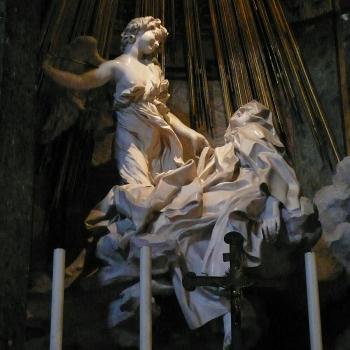A really rambling post.
Now that my book is out I’ve been doing a lot of interviews, and in many of them I’ve been asked to tell my conversion story. A huge part of my conversion involved realizing that the Catholic Church wasn’t what I’d thought it was. For example, I had this image that the Church opposed and rejected the human body–the beauty of the body, the joy of the senses–and denigrated all sensual beauty and pleasure, from the beauty of a Japanese maple to the ecstasy of sex. (I’m not sure how I reconciled this belief with my love of a lot of Catholic artwork and religious/liturgical items, like reliquaries, but hey, I was a teenager, coherence is overrated etc etc.) Friends of mine pointed out that this isn’t what the Church is. God is the Creator; His creation is not only begun, but sustained in every moment, solely through His love. The beauty of our bodies and the world around us is His fingerprints.
But when I said this stuff in interviews, some of the interviewers rightly pushed back on it. If the body is so great, how come you’ve accepted celibacy?, they asked. I tended to get pretty defensive about this, which is a sign that the interviewers were picking up on a real thing I was grappling with but hadn’t fully acknowledged.
A couple things I’ve read recently have helped me tease out some elements of the way I approach these questions. One is that beautiful piece, “How Should Secular People Approach Sacred Art?” Pelagia Horgan’s descriptions of Fra Angelico’s artwork–and the luminous reproductions of the work itself–show so clearly how a celibate monk can enter completely into the beauty and meaning of the physical world and the human body. The painter’s attention kisses the world into color: the rippling wings of the angel, the deep soaking blues and fairy-tale forest greens, the golden flesh of the blessed. There’s a kind of mercy in his work, an acceptance.
I’ve always loved these painters who heighten our experience of the body and the sensual world: de Zurbaran’s scraped and glowing saints; Sanchez de Cotan’s sacramental vegetables. These artworks clear away the clutter of our ideas and projections, and show us the world a little closer to how it looks to God. Still grimy, still bruised and bloodied, but utterly loved and understood.
So then is sex simply irrelevant to the meaning and beauty of the body and the world? Can I just say, “Why do you guys think celibacy has anything to do with the beauty of the body?” and leave it at that? I mean, nobody’s gonna have sex with a cardoon (…please don’t tell me otherwise) and yet when I look at Sanchez de Cotan’s work it’s visceral, electric, feverish. You feel the rough, callused hand of the Creator God.
But no, sex is–can be–one way we enter into this beauty of the body and the physical world. That “Broom People” mindset, sex as ecstatic contact with the truth of our nature as created beings, sex as prayer of thanksgiving: That’s something I think I’ve experienced to a very limited extent, and long for.
(It’s easy for this ecstatic view of sex to become wishful thinking. There’s a reason the characters in “Broom People” are adolescents–and, I think, a reason the narrator is a straight guy. Straight women get a lot of painful lessons in the less theological aspects of sex. I’ve been in a few conversations where some well-meaning celibate gay person is like, “I love the theology of the body! It’s so beautiful!”, and actual married Catholics are all, “…Yeah uh, it’s great I guess, marriage isn’t really like that though. Or married sex. No offense, honey.”)
I think David Foster Wallace is onto something with this list: “Drugs, movies where stuff blows up, loud parties—all these chase away loneliness by making me forget my name’s Dave and I live in a one-by-one box of bone no other party can penetrate or know. Fiction, poetry, music, really deep serious sex, and, in various ways, religion—these are the places (for me) where loneliness is countenanced, stared down, transfigured, treated.” (which I found here, so no clue if he really said it, research is for losers)
If what you want is to live in your skin, to live in and love the world rather than just “coping with” it, then yeah, there are things which art, (some kinds of) sex, and prayer have in common. I don’t get to do one of those things, due to factors outside my control. That’s true of plenty of people (let’s all shed exactly no tears for men who whine about being “involuntarily celibate” like women owe them something) but it’s okay to say that it is a loss.
In a certain way realizing that sex can be analogous to prayer helps me better understand and accept celibacy. Sometimes when I pray I am able to experience in some way God as Creator. In the book I describe this as “see[ing] the Crucifixion shining through the apparent world,” but it isn’t always quite that flamboyantly Spanish. Sometimes it’s more like the merciful light which flows through Fra Angelico’s work. These moments are examples of what Catholics call “consolations.” They’re gifts of God, dispensed by Him seemingly at random. Infrequent, for me, but memorable. They aren’t the point of prayer, and you pray whether or not you receive these consolations; you accept that God will give you these experiences or not and it’s up to Him.
There may be reasons and rhythms behind God’s decisions to scatter or withhold these consolations. I assume He’s got his reasons. I do believe there are reasons, beautiful patterns, behind the Catholic sexual ethic. But I don’t have to understand or discern them in order to accept the ethic. I can be grateful for the ways in which I do get to enter into the beauty of the body, without demanding that I get to try all the ways, or demanding that I get to experience my body on my own terms. Reception of a gift is better than self-determination anyway–at least if you love and trust the giver.
Ah, this really is a weird rambling post, and I certainly don’t intend it to persuade anyone of any of my various controversial positions. But I hope it gives a bit of a window into how the world looks to me, for those who wonder how this all works experientially; and I hope it can be a bit illuminating or provocative for others.











